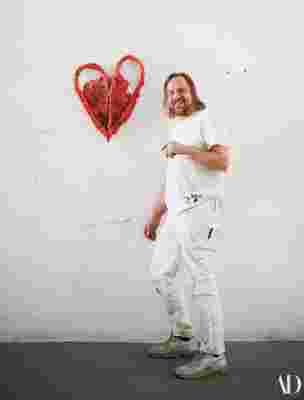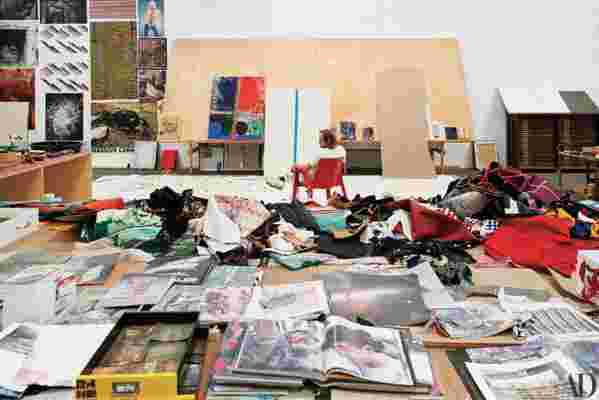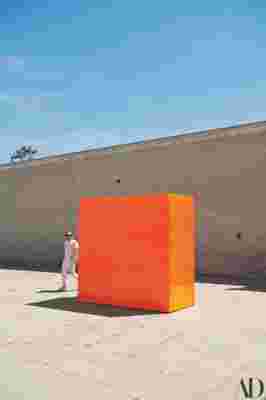Sterling Ruby seems to enjoy pricking the membrane of esoterica and fabulousness that shrouds the contemporary-art world. Despite his ascension to its highest echelons, he chafes at the shibboleths and not-so-subtle snobbery of the fickle international art scene. Prodigious output across a wide range of media; a refusal to choose between spectacle and sincerity; outsize ambition; phenomenal commercial success attained early in a career—all of these tend to raise eyebrows among the art world’s traditional gatekeepers. But Ruby takes it all cum grano salis. He’s just doing his thing.

Sterling Ruby in his Los Angeles-area studio.
Consider the artist’s vast studio in Vernon, California, a small industrial city of warehouses, factories, and the occasional adult-entertainment superstore, just five miles south of downtown Los Angeles. The complex sits on four acres, with roughly 122,000 square feet of indoor space. Ruby purchased the property six years ago and spent three years on renovations, which included the replacement of 116 skylights. There are massive studios dedicated to work in various media, along with viewing rooms and storage and support facilities (e.g., woodworking and welding). Just off the entry to the compound, Ruby has a 10,000-square-foot gallery with a 40-foot ceiling, where he can study his work and install exhibition mock-ups at full scale.
Even by the XXL standards of the art world of 2018—where galleries operate like multinational conglomerates and museums can’t stop hawking their latest starchitect makeovers—the scale of Ruby’s enterprise feels audacious. “I was on top of myself in my old studio. I never had room to look at things with space around them. To photograph one thing, we’d have to move everything else,” the artist says. “Now I have more time and space to make decisions when I’m finishing a piece or a series. I can sit back and take a valuation of the colors, the palette, the patterns, as well as what the work means to me and where I feel it comes from. I can figure out if I need to throw a red herring into the mix.”
I wanted to make something expressive where you can see the tactility, something with chance in the process.
The four primary art studios are allocated to painting (specifically large-scale canvases), drawing (including collage and small-scale painting), ceramics, and textiles (soft sculpture, tapestries, and garment construction). At any given time, certain studios show signs of active production while others remain completely quiet. Despite his team of 16 assistants, one gets the impression that Ruby often inhabits the space alone, roaming from studio to studio as inspiration strikes, occasionally crossing paths with a kiln technician or seamstress. “I get manic, so I like to move around,” he explains.

Ruby surveying his work in the studio dedicated to drawing and small-scale painting.
In recent months, the ceramics studio has kicked into high gear in preparation for the first museum exhibition devoted exclusively to Ruby’s work in that medium. Organized by the Des Moines Art Center, the show, titled simply “Sterling Ruby: Ceramics,” debuted in Iowa this past summer. It moves to New York City’s Museum of Arts and Design for a five-and-a-half-month run starting on October 3.
Given the recent surge of interest in ceramics among contemporary artists and collectors, and the backlash from the established ceramics community—they decry the arrivistes’ insistence on wonkiness as a signifier of authenticity—Ruby is quick to point out that he has worked in clay for nearly two decades. “Honestly, I don’t think I would have done ceramics if I’d started five or six years ago. When I first became interested in the material, it felt like uncharted territory. Clay was still seen as craft, with none of the conceptual imperative that dominated contemporary-art theory and practice,” he insists. “I wanted to make something expressive where you can see the tactility, something with chance in the process, particularly in the firing,” he adds.

Ruby’s connection to ceramics dates back to his youth. When the German-born artist was a child, his family moved from Europe (where his American father was stationed with the U.S. Air Force) and ended up at a farm near New Freedom, Pennsylvania, in the heart of Pennsylvania Dutch country.
“I grew up in a place that highly valued craft. My mother, who was Dutch, brought a lot of her West German pottery and dishware to the States. It was typically lumpy and thickly glazed. In regard to my autobiography,” he continues, “I felt like I had a history with that particular material that I should play up in my art.”
The current exhibition surveys a broad range of Ruby’s ceramic sculptures, from the hefty basins that he fills with shards of earlier works that failed in construction or firing to smaller works that he describes as totems, soldiers, and ashtrays. Certain pieces riff on the shape of a heart, beautifully glazed in a broad range of hues. The heart sculptures may be a sly undermining of the outmoded conflation of clay and craft—akin to something one might encounter at the local art fair, down the aisle from the batik ponchos and driftwood lamps. Or perhaps it’s just a red herring.
